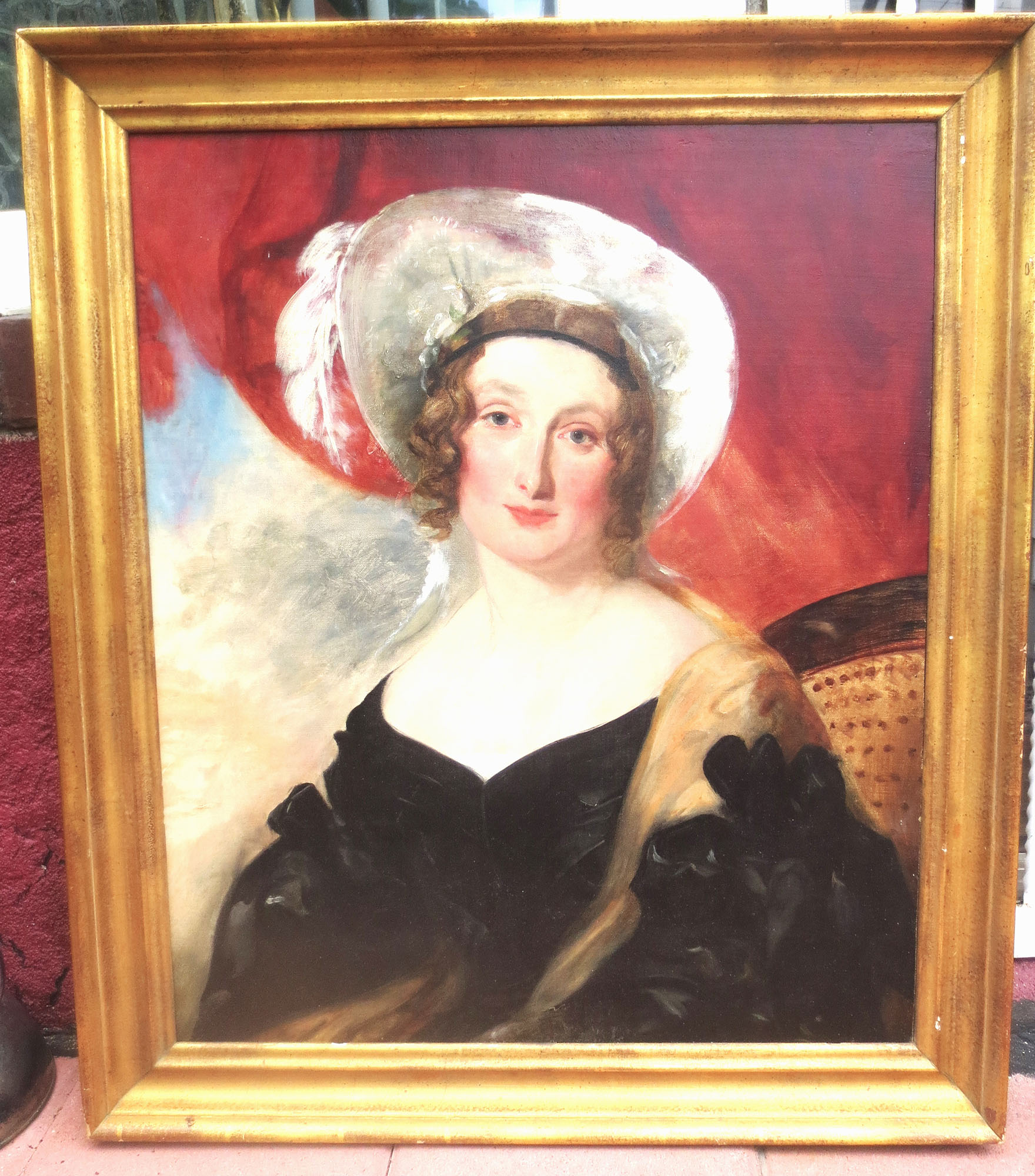As a plausible portrait by Sir Thomas Lawrence (1769-1830) of Mary Shelley (1797-1851) at thirty-two, this painting closely resembles in pose, setting and handling several other portraits begun by Lawrence in the later 1820s. Although not entirely completed, in large measure this painting was already far further advanced than most of his other non completo from this period, with the sitter and setting already nearly complete. Only the sitter’s bonnet, already fully indicated in an elaborated outline, remained an open field of ground tone broken only by a few wide trial sweeps of a potential local color.
Then too, traces of the artist’s functional hand are seen in the graceful preliminary outlines firmly drawn and still clearly visible along the sitter’s neck and shoulder in anticipation of some further covering of obfuscating half tone shading.
Similar outlines can again be traced within the paint strokes delineating the neck and shoulder in Lawrence’s portrait of Julia, Lady Peele (c. 1827; New York, Frick Collection; Collection; cf. K.Garlick, Sir Thomas Lawrence, New York, 1989, No. 638b). Both the inchoate and the completed portraits are comparable in the age, pose and setting of their sitters. Each face was framed by a large bonnet of similar scope and shape that provided a kind of tondo frame within the larger rectangular field of the painting, Lady Peele’s bonnet fully black, the other of undetermined color. As a distinctive color key to the calibration of flesh tints in both portraits, Lady Peele’s bonnet is plumed by deep red feathers, whereas in the other a deep red backdrop curtain also serves to gauge the effect of the calibrated modulations of the rouge tones of cheeks and lips.
As an emphatic contrast to these warm reds in both paintings, in each a similar cool gray blue sky prevails, painted with similar wide sweeps of brush play. These freely painted passages are deliberate markers of the homogenous unity of creative effort by a singular mind and hand responsible for both paintings. The only marked difference between them is not in the external effect of costume parerga, but in the distinct difference in the revelatory sensibility of the portrayal: one as cosmetically appealing and the other as introspectively sentient.
Indeed, only one of two good reasons for the paucity of portraits of Mary Shelley would have been the rigors of her life as an often impecunious widow, author and editor within a cautiously managed social circle despite her meager means and somewhat worn. Whatever her inner governance of vanity may have been, Mary Shelley was usually reluctant to sit for a publicly exhibited or reproduced portrait. In that vein, on 10 February 1835, she objected to a portrait for inclusion in a biography of Byron with the admonition: “I have much a dislike of display.” (MSJ p. 559 n. 1). But it is also clear that Lawrence held a special place in Mary’s affections and respect, and if any were to paint her portrait in her emergent professional life, he would be the single most congenial candidate. After all, as the progeny of Lawrence’s friends Thomas Godwin and Mary Wollstonecraft, Mary had known Lawrence from her own childhood on.
For the record, Mary Shelley’s deeply felt regard for Lawrence as an old family confident was tersely but potently expressed in her journals, beginning with the notation of a pleasant visit to Lawrence’s studio on 8 October 1829, to join their mutual friend, the poet and Byron’s biographer Thomas Moore, who was sitting to Lawrence that morning (MSJ p. 511). The second significant note entered on 9 January 1830 had a tragic ring when a legibly distraught Mary recorded Lawrence’s death two days earlier: “Poor Lawrence is dead – Having seen him so lately the suddeness of this event affects me deeply…” (MSJ p.512).
Between these two moments of joy and sorrow involving the portrait painted of a mutual friend, the phrase ‘seen him so lately’ stands out as implying a more recent contact with Lawrence than the three months elapsed since the studio meeting with Lawrence and Moore. That would allow three elapsed months in which a portrait of Mary, too, could have been begun, substantially advanced, and sadly aborted just before completion by Lawrence’s untimely death on 7 January 1830. (Both Moore and Godwin remarked in their journals on the intensity of Mary’s grief over this loss. (cf.s.v. in MSJ).
There does not appear to have been much if any effort at the relatively simple task of filling in the bonnet and so more or less finishing up this particular unfinished painting on the part of his protégé and studio assistant Richard Rothwell who had been charged with the preparation for sale of Lawrence’s last unfinished paintings. To what extent this work progressed must still be determined by careful analysis of the later and still only partially finished paintings, a task not within the purview of the standard and quite commendable monograph on the artist where Rothwell is by tacit neglect implicitly not credited with any independent work in the Lawrence studio in the year after his death.
Moreover, several other factors would have hindered any work on this specific painting or the costly inception of a new portrait of the impecunious Mary Shelley. Simply put, the press of work readying potentially more remunerative paintings would have precluded work on an unfinished portrait done out of friendship for a dear but impoverished family friend. Apparently, even the completion of the bonnet was not attended, simple as it might have been had the effort been commercially warranted. Then too, by early March and May of 1831, Mary was again in a poor state of health and not up to the extended effort of sitting for a new portrait, as suggested by hew own entry for 10 May 1831: “I have been very ill all this time – cast down – languid & in pain…” (MSJ p. 520-521). It is hard to make much sense of the less than fully reliable Godwin’s oblique note on 18 May 1831 that Mary was again ready to sit for a portrait by Rothwell.
However, no original Rothwell portrait of Mary Shelley is now known or previously recorded of such a portrait, although near ten years or so later Rothwell did paint a portrait of Mary Shelley for public exhibition that remains the only fully documented such now known). In any event, suitable time for such a venture would have interfered with Rothwell’s work finishing up Lawrence’s unfinished bespoke portraits, which was never fully achieved. It seems more likely that the oft errant Godwin simply noticed that Mary might have enabled Rothwell to finish up a portrait by his erstwhile master, although that too is discredited by the permanently unfinished state of the bonnet (MSJ p. 521 n.6). Finally, any projected portrait of Mary Shelley either in repair of an earlier one or as a new one by Rothwell was cancelled before progressing by mid-1831 when Rothwell departed for a three year stay in Italy, leaving many of Lawrence’s remaining unfinished paintings still untouched.
In 1840, long after Rothwell’s return to England and entry into Mary’s wider entourage, Rothwell did paint her portrait ab ovo for public exhibition the next year. This painting became the standard likeness of Mary, albeit one reflective of her recent bouts of serious and continuous debilitating illness in early middle age (cf. Muriel Spark, Mary Shelley, New York, 1987, pp. 131-133 with further references to Godwin’s journals.) Still stoically intelligent and loathe to undue vanity, Rothwell’s portrait is superficially altered by the symptoms of Mary’s dreaded illness and melancholy. For the most part, the resilience of supportive bone fixes the immutable features of chin, nose and brow as seen in the Lawrence painting; but now hard bone has prevailed with the aging diminution of the healthy cover of pliant flesh: the eyes are the same but set into slightly deeper sockets beneath a harder edged brow; the cheeks are thinner and the brow higher with the loss of hair to an illness that plagued Mary.
In effect, the objectively detached later Rothwell painting portrays a stoic survivor of the emotional wounds of great losses – “the grave is a crowded place” she once wrote as husband, three children and valued friends left life all too soon.
Ironically, the lingering reflections of youth, pale but softly smiling in the unfinished portrait, has also allowed the full rounded umbra of her eyes to admit the lasting measures of sadness that haunted her from childhood on; in effect, while Rothwell would later paint the skeletal facts of an aging and resiliently stoic woman, the earlier portrait has grasped the ironic human dichotomy of melancholic reflection harbored in the fiercely sentient spirit of a most versatile intellect. This was not a casual or commercial portrait at all, but a sincere testament to the character and nature of a dear lifetime talent and friend by a painter who knew his own artistic range when inspired by the transcription in paint of the complex soul of his subject, eschewing cosmetic confection for a deeply empathetic testament to her in her courageous prime.

